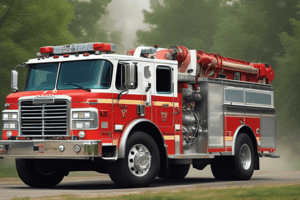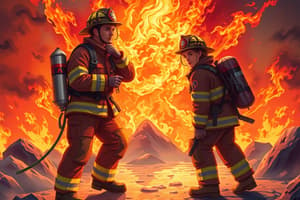Podcast
Questions and Answers
What is the responsibility of a local fire officer during an initial investigation?
What is the responsibility of a local fire officer during an initial investigation?
To conduct the investigation.
An accident is defined as any expected event that interrupts fire department operations.
An accident is defined as any expected event that interrupts fire department operations.
False (B)
Which of the following are included in the results of an accident investigation? (Select all that apply)
Which of the following are included in the results of an accident investigation? (Select all that apply)
- Corrective actions needed (correct)
- Personal opinions of witnesses
- Cause of the event (correct)
- Circumstances of the event (correct)
What is meant by 'risk management' in fire departments?
What is meant by 'risk management' in fire departments?
What program aims to prevent line-of-duty deaths and injuries for firefighters?
What program aims to prevent line-of-duty deaths and injuries for firefighters?
What should be done immediately after exposure to an infectious disease?
What should be done immediately after exposure to an infectious disease?
The fire department can control fire station safety hazards at all times.
The fire department can control fire station safety hazards at all times.
Who ensures thorough investigation of all hazardous conditions and accidents?
Who ensures thorough investigation of all hazardous conditions and accidents?
What role does an incident safety officer play?
What role does an incident safety officer play?
What is risk management?
What is risk management?
Which of the following are responsibilities of the fire chief regarding community fire risk management? (Select all that apply)
Which of the following are responsibilities of the fire chief regarding community fire risk management? (Select all that apply)
What are the three types of control used in risk management?
What are the three types of control used in risk management?
List the five principal risk management steps.
List the five principal risk management steps.
What is the trend in fire fighter fire-ground fatalities since 2007?
What is the trend in fire fighter fire-ground fatalities since 2007?
What program was developed by NFFF to prevent line-of-duty deaths and injuries?
What program was developed by NFFF to prevent line-of-duty deaths and injuries?
What contributes to the leading cause of death among fire fighters?
What contributes to the leading cause of death among fire fighters?
Only new recruits need to undergo medical examinations before responding to incidents.
Only new recruits need to undergo medical examinations before responding to incidents.
What are the components of a fire department infection control program required by NFPA 1581?
What are the components of a fire department infection control program required by NFPA 1581?
What are some reasons for fire fighter deaths during training activities? (Select all that apply)
What are some reasons for fire fighter deaths during training activities? (Select all that apply)
What type of procedures should be followed after emergency medical incidents to control infections?
What type of procedures should be followed after emergency medical incidents to control infections?
Flashcards are hidden until you start studying
Study Notes
Introduction to Safety and Risk Management
- Dedicated collaboration is essential to reduce firefighter injuries and deaths.
- A comprehensive safety program must integrate multiple components for effectiveness.
Fire Officer's Role in Risk Management
- Risk management involves planning, organizing, directing, and controlling resources to minimize harm.
- Responsibilities of fire officers include identifying and evaluating risks, ranking them, implementing controls, and revising actions.
Community Fire Risk Management
- Fire chiefs have three core responsibilities:
- Manage community fire risk.
- Provide risk management services.
- Maintain fire department operational readiness.
- Risk control methods include administrative guidelines, engineering solutions, and personnel protection equipment.
Principal Risk Management Steps
- Five key steps for effective risk management:
- Identify risk exposures using relevant reports and comparisons.
- Evaluate the likelihood and consequences of risks.
- Rank and prioritize risks based on frequency and severity.
- Determine and implement control actions through various means.
- Evaluate and revise the effectiveness of risk control measures.
Firefighter Injury and Death Trends
- Firefighters must be prepared for unsafe situations; NFPA reports detail injuries and fatalities in operations.
- Approximately 26 firefighter fatalities occur per year, with prevention reliant on halting dangerous events.
Everyone Goes Home Program
- Developed by the National Fallen Firefighters Foundation (NFFF) to prevent line-of-duty deaths and injuries.
- Established 16 safety initiatives to promote best practices in operational situations.
- Efforts show a decline in line-of-duty deaths since 2014.
National Firefighter Near Miss Reporting System
- Launched in 2005 to report near misses, enhancing safety and operational reliability.
- Inspired by successful reporting systems in aviation.
Reducing Deaths from Cardiac Arrest
- Higher risk for firefighters over 49 years of age.
- Candidates should undergo medical evaluations; fitness training is essential.
- Resources promote healthy living and physical fitness.
Reducing Deaths from Suicide
- Suicide statistics show significant numbers of firefighter casualties, highlighting the need for peer support and mental health initiatives.
Reducing Deaths from Cancer
- Increased cancer risk due to synthetic materials in modern fires—firefighters face a 9% higher diagnosis rate than the general population.
- Firefighter Cancer Registry is in place to monitor health trends and promote prevention practices.
Reducing Deaths from Motor Vehicle Collisions
- Continuing low trends in deaths from vehicle incidents responding to alarms.
- Importance of proper training and seat belt use emphasized to prevent fatalities.
Reducing Deaths in Fire Suppression
- Internal trauma/crushing main non-cardiac death cause, alongside asphyxia and burns.
- Ensuring crew integrity and effective air management is crucial during operations.
Training Safety
- Adequate training is vital for competence and high-performance team operations.
- Emphasis on identifying safety issues and implementing proactive training measures to reduce risk.
Incident Safety Officer Role
- The incident safety officer monitors emergency scenes, identifies hazards, and ensures safety policies are followed.
- Immediate authority to halt unsafe actions is mandated to protect personnel.
Creating a Safe Work Environment
- Injury prevention is crucial; officers must model safe behaviors and ensure policy compliance.
- Safety policies often stem from previous incidents—officers are responsible for instructing and enforcing those policies.
Infection Control
- Fire departments must maintain an infection control program as per NFPA guidelines.
- Key components include written policies, risk management, training, and handling decontamination post-incidents.
Accident Investigation
- Health and safety officer oversees investigations related to injuries, illnesses, and fatalities.
- Investigations aim to identify causes, recommend corrective actions, and ensure accurate documentation.
Postincident Analysis
- Incident safety officers compile reports on safety and health issues after an event, focusing on lessons learned for future prevention.
Summary of Risk Management Principles
- Effective risk management involves systematic planning and organization to minimize negative impacts within fire departments and the broader community.### Firefighter Safety and Preparedness
- Firefighters face high-risk situations and must be fully prepared to ensure safety.
- Everyone Goes Home is a program by the National Fallen Firefighters Foundation aimed at preventing deaths and injuries, comprising 16 Firefighter Life Safety Initiatives.
Incident Reporting and Trends
- The goal of www.firefighternearmiss.com is to collect data on near-miss incidents to identify trends and share findings confidentially.
- Sudden cardiac arrest is the leading cause of on-duty firefighter fatalities.
- Firefighter suicide rates exceed those of line-of-duty deaths, highlighting a critical mental health concern.
Incident Safety Officers
- An incident safety officer monitors scenes for hazards and ensures compliance with safety protocols.
- All fire officers should be trained to fulfill incident safety officer duties if needed.
- Complex incidents may require multiple safety officers to manage responsibilities effectively.
Rehabilitation and Injury Prevention
- A rehabilitation process at incident scenes includes medical evaluation, monitoring, and rest to support firefighter recovery.
- Programs should encompass both injury prevention and safety to address near misses and fatalities holistically.
Policy Adherence and Safety Culture
- Fire officers must thoroughly understand and adhere to safety policies, ensuring compliance among all team members.
- Emphasizing physical fitness and proper use of personal protective equipment is key to injury prevention.
- Safety hazards exist in both emergency incidents and the fire station, necessitating continuous vigilance and corrective measures.
Infection Control and Initial Responses
- Every fire department should have an infection control program that complies with NFPA 1581 standards.
- Immediate response to exposure from infectious diseases involves washing the affected area thoroughly with soap and water or suitable alternatives.
Investigation of Incidents
- The health and safety officer is responsible for investigating injuries, illnesses, and hazardous conditions within the department.
- Fire officers often conduct initial investigations of minor accidents to identify risks and prevent recurrences.
- Post-incident analyses provided by the incident safety officer include safety and health insights relevant to the incident.
Studying That Suits You
Use AI to generate personalized quizzes and flashcards to suit your learning preferences.




